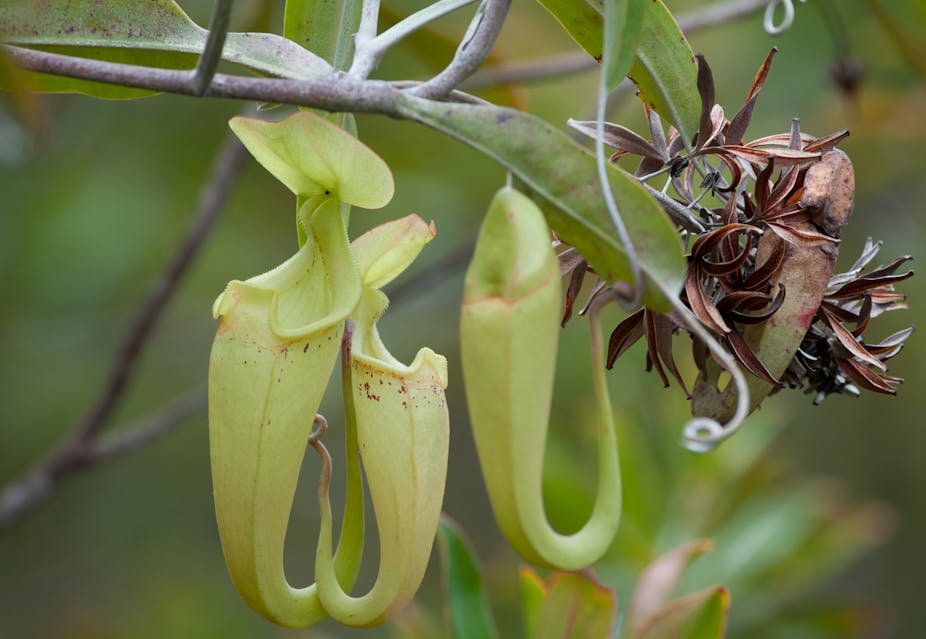Sometimes less can be more. Carnivorous pitcher plants from the tropical island of Borneo (Brunei) demonstrate this quite impressively. These plants use funnel-shaped pitfall traps, or pitchers, with slippery slopes to capture insects. Once they slip, the insects drown in a pool of digestive liquid and the plants feed on the released nutrients.
This unusual feeding strategy allows pitcher plants to survive on extremely poor soils where other, “normal” plants struggle. Because pitcher plants rely so heavily on capturing prey, one should expect their traps to be optimised for catching as much prey as possible. So it came as a surprise that the most widespread trapping surface is only slippery when it is wet by rain or condensation, but not when dry.
When I went out to study Nepenthes rafflesiana pitcher plants in Borneo for my PhD project in 2006, I noticed that the trapping surfaces were dry and safe for insects to walk on for up to eight hours a day. Did pitcher plants just fail to evolve a better solution, or did they evolve in a constantly wet environment and are now living under sub-optimal conditions?
Evolutionary “failure” can be ruled out rather quickly. Many species possess other, slippery surfaces independent of wetness – and the young seedlings of N. rafflesiana use permanently slippery wax crystal surfaces for trapping prey. The mature plants, however, have lost the wax crystals and rely entirely on the trapping surface becoming wet through rain or dew. So why do the plants “abandon” an effective trapping device in favour of a seemingly flawed one?

The key to the answer lies in the plant’s prey, as we found in a new study published in the Proceedings of the Royal Society. For many pitcher plant species, including N. rafflesiana, ants are the major prey. As social insects, ants live in colonies with a clear division of labour. Only the queen reproduces – while other vital tasks, such as foraging, brood care or defence, are carried out by various worker castes. In order to find lucrative food sources, the colony sends out “scout” ants that explore the surroundings of the nest.
Nepenthes pitchers produce a lot of sweet nectar to attract insects. If a scout ant arrives at a pitcher during dry times, it can safely return to the colony and lead its fellow ants to the nectar source. When the trap gets wet and slippery later, these followers get caught in one sweep. In contrast, a trap that is super-slippery at all times would capture the scout ants, thereby cutting off its own “prey supply”.
We tested this idea by fitting some pitchers in the field with a hospital drip that kept the trapping surface wet at all times. We then compared the amount of prey caught by these pitchers with that caught by natural, alternately wet and dry pitchers. We found that naturally alternating traps caught in total almost 2.5 times as many ants as the constantly wet ones. This was not evenly distributed though: most traps caught hardly any ants, regardless of the conditions. However, under natural conditions where the plants’ trapping surfaces are alternately wet and dry, a few pitchers made spectacular catches, occasionally more than 100 ants within just two days. This never happened when the traps were kept constantly wet.
Constantly wet traps, in contrast, captured more non-recruiting prey such as flies, stingless bees or beetles. This makes sense because the wet traps were “active” for longer, increasing the chance of capturing random visitors. Nevertheless, this moderate increase in non-ant prey through constant wetting could not offset the loss of ant prey: overall, naturally alternating traps caught 36% more prey than wet traps. Such a stark difference explains why a mechanism that at first sight seems disadvantageous, can persist in evolution.

